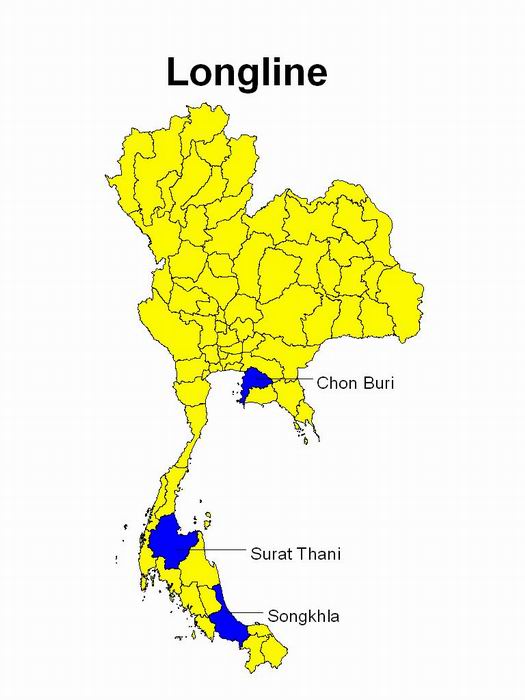Longlines
The
bottom longline is the most common type of hook-and-line
gear in Thailand. It consists of a main line, branch
lines (hook lines) and hooks. The construction of bottom
longline gear used in Thailand is the most common and general
type of bottom longline gear. The main line is usually
made of vinylon, which is dyed with juice obtained form mangrove
bark. When polyethylene is used for the main line,
sinkers are attached to it directly or to the joints between
the main line and branch lines, in order to increase the
sinking force.
Polythylene
is the main material for the branch lines, but nylon monofilament
is also used quite frequently. The interval between
two adjacent branch lines is 2.0-2.5 m, when the target species
are large-sized fish, such as red snapper, grouper and Spanish
mackerel. The length of branch lines for this type
of gear is 40-60 cm. When the target species are medium-sized
fish, such as threadfin and marine cat-fish, the branch lines
are spaced less widely, about 1.4-2.0 m apart, and the length
of a branch line is about 50 cm.
The
bottom longline for ray is somewhat different from an ordinary bottom longline
described above. The branch lines in this gear are fastened close together,
with intervals of only about 27-33 cm. The branch lines are slightly
shorter than the interval, 25-30 cm. The catching mechanism of a bottom
longline for ray is different from that of an ordinary longline gear. In
the latter case the fish to be caught is attracted by bait, where as the bottom
longline for ray entangles and hooks the fish without bait.
The
hooks for ordinary bottom longline are all of nearly the
same shape, but vary in size. This type of hook has
a long shank and a rounded bend. The length of shank
ranges from 2.0 cm to 5.5 cm. All the hooks are barbed. The
hooks for the bottom longline for ray are shaped differently
from the hooks used for the ordinary bottom longline. They
are long and angular, with a very sharp point but with no
barb on it. Hooks are dipped in soya bean oil after
operation to protect them from rusting coconut oil is not
used, because of strong smell.
Hooks
are arranged on a wooden or bamboo “hanger” which
is called tap in Thai, meaning “a set”. The
length of a hanger for an ordinary bottom longline is 50-80
cm, which is sufficient to accommodate about 120-200 hooks. The
hanger for a longline for ray is about 120-135 cm long, and
about 300 hooks are arranged on it.
Bottom
longline are usually operated early in the morning. Shooting
is done while removing hooks from the hanger which is stood
up-right and attaching bait on one hook after another. The
number of hooks used for one operation depends on the size
of the boat and the construction of gear, but an ordinary
bottom longline has between 600 and 1500 hooks. In the case
of the bottom longline for ray bait is not used. Therefore
shooting is done as the hooks are removed from the hanger. As
the interval between two adjacent branch lines is very short,
3-5,000 hooks are used in an operation.
Bait
for an ordinary bottom longline is sardine or mackerel, whose
body size is about 10 cm. Fish are cut into halves,
head and tail part, and used for baiting snapper, grouper,
Spanish mackerel and other fish. Squid is also good
bait for longline, but it is not used widely, because the
price of squid is sometimes quite high. In some cases,
for example when fishing for the fourfinger threadfin, live
bait is used. This is usually small mullet, about
7-8 cm long.
With
an ordinary bottom longline, hauling of line the gear starts
immediately after the shooting is finished. The bottom
longline for ray is kept on the bottom for two hours or more
before hauling. There is no facility for hauling line
aboard ship. Hauling is done entirely by hand.

|